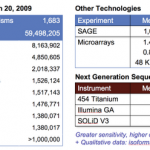transcriptome
Day 4 of the meeting turned out to be pretty exciting for a comparative physiologist as well.
The first session that I went to was called "RNASEQ approaches to understanding extreme physiological adaptations." Considering the Comparative and Evolutionary Physiology section business and dinner meeting was the night before, I was impressed at my ability to make it to an 8:00am session the following morning.
The first seminar from Dr. Brooke C Harrison (Univ. Colorado, Boulder) was on "Extreme cardiac growth and metabolism in the Burmese python after feeding." He spoke about how the cells…
I had the good fortune on Thursday to hear a fascinating talk on deep transcriptome analysis by Chris Mason, Assistant Professor, at the Institute for Computational Biomedicine at
Cornell University.
Several intriguing observations were presented during the talk. I'll present the key points first and then discuss the data.
These data concern the human transcriptome, and at least some of the results are supported by follow on studies with data from the pigmy tailed macaque.
Some of the most interesting points from Mason's talk were:
A large fraction of the existing genome…
For the past few months, the shake-up that began with Next Generation DNA Sequencing has been forcing me to adjust to a whole new view of things going on inside of a cell. We've been learning things these past two years that are completely changing our understanding of the genome and how it works and it's clear we're never going back to the simple view we had before.
What's changed? The two most striking changes, to me at least, are the new views of the way the genome is put together and what the cell does with the information.
They just don't assemble chromosomes like they used to.
I used to…

